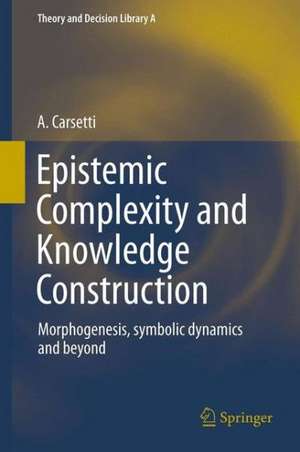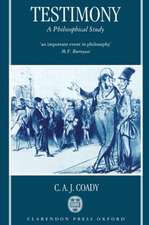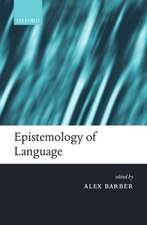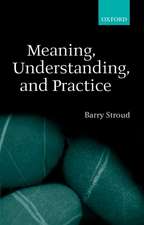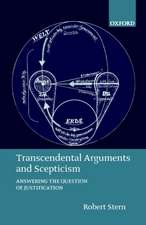Epistemic Complexity and Knowledge Construction: Morphogenesis, symbolic dynamics and beyond: Theory and Decision Library A:, cartea 45
Autor A. Carsettien Limba Engleză Hardback – 5 apr 2013
As is well known, cognition is not only a self-organising process. It is also a co-operative and coupled process. If we consider the external environment as a complex, multiple and stratified Source which interacts with the nervous system, we can easily realise that the cognitive activities devoted to the "intelligent" search for the depth information living in the Source, may determine the very change of the complexity conditions according to which the Source progressively expresses its "wild" action. In this sense, simulation models are not neutral or purely speculative: the true cognition actually appears to be necessarily connected with successful forms of reading, those forms, in particular, that permit a specific coherent unfolding of the deep information content of the Source. Therefore, the simulation models, if valid, materialise as "creative" channels, i.e., as autonomous functional systems, as the very roots of a new possible development of the entire system represented by mind and its Reality. From a general point of view, the objectivity of Reality is also proportionate to the autonomy reached by cognitive processes.
In this sense, at the level of cultural evolution, reference procedures act as guide, mirror and canalisation with respect to primary information flows and involved selective forces: they offer themselves as the actual instruments for the constant renewal of the code, for the invention and the actual articulation of an ever-new incompressibility. From an effective point of view, they appear as indissolubly linked to the successive definition of specific (and innovative) measures of the epistemic complexity. These measures cannot concern only statistical rarity (Shannon) or computational incompressibility (Kolmogorov-Chaitin), on the contrary they should also be able to take into account the coupled connection between the Source and the cognitive agent, the evolution of this connection as well as the successive constitution of meaning as symbolic form. Hence the possible (and necessary) definition of new axiomatic systems, new measure spaces, the real displaying of processes of continuous reorganisation at the semantic level. Indeed, it is only through a complete, first-order "reduction" and a correlated non-standard second-order analysis that new incompressibility will actually manifest itself. Therefore, the reference procedures appear to be related to a process of multiplication of minds, as well as to a process of "clarification" of meanings which finally emerges as vision via principles.
| Toate formatele și edițiile | Preț | Express |
|---|---|---|
| Paperback (1) | 549.58 lei 38-44 zile | |
| SPRINGER NETHERLANDS – 12 apr 2015 | 549.58 lei 38-44 zile | |
| Hardback (1) | 560.01 lei 38-44 zile | |
| SPRINGER NETHERLANDS – 5 apr 2013 | 560.01 lei 38-44 zile |
Din seria Theory and Decision Library A:
- 18%
 Preț: 952.40 lei
Preț: 952.40 lei -
 Preț: 382.57 lei
Preț: 382.57 lei - 18%
 Preț: 958.25 lei
Preț: 958.25 lei - 18%
 Preț: 949.23 lei
Preț: 949.23 lei - 18%
 Preț: 1232.09 lei
Preț: 1232.09 lei - 15%
 Preț: 643.34 lei
Preț: 643.34 lei - 18%
 Preț: 948.92 lei
Preț: 948.92 lei - 15%
 Preț: 581.79 lei
Preț: 581.79 lei - 15%
 Preț: 644.49 lei
Preț: 644.49 lei - 15%
 Preț: 642.83 lei
Preț: 642.83 lei -
 Preț: 389.70 lei
Preț: 389.70 lei - 18%
 Preț: 947.67 lei
Preț: 947.67 lei - 15%
 Preț: 641.20 lei
Preț: 641.20 lei -
 Preț: 388.90 lei
Preț: 388.90 lei - 15%
 Preț: 640.37 lei
Preț: 640.37 lei - 18%
 Preț: 952.26 lei
Preț: 952.26 lei - 15%
 Preț: 641.20 lei
Preț: 641.20 lei - 18%
 Preț: 953.35 lei
Preț: 953.35 lei - 18%
 Preț: 952.89 lei
Preț: 952.89 lei - 18%
 Preț: 951.47 lei
Preț: 951.47 lei - 15%
 Preț: 636.94 lei
Preț: 636.94 lei - 18%
 Preț: 944.82 lei
Preț: 944.82 lei - 15%
 Preț: 643.84 lei
Preț: 643.84 lei - 18%
 Preț: 1383.81 lei
Preț: 1383.81 lei - 18%
 Preț: 1331.51 lei
Preț: 1331.51 lei - 20%
 Preț: 641.99 lei
Preț: 641.99 lei - 15%
 Preț: 647.40 lei
Preț: 647.40 lei
Preț: 560.01 lei
Preț vechi: 700.01 lei
-20% Nou
Puncte Express: 840
Preț estimativ în valută:
107.17€ • 111.48$ • 88.48£
107.17€ • 111.48$ • 88.48£
Carte tipărită la comandă
Livrare economică 10-16 aprilie
Preluare comenzi: 021 569.72.76
Specificații
ISBN-13: 9789400760127
ISBN-10: 9400760124
Pagini: 164
Ilustrații: X, 151 p.
Dimensiuni: 155 x 235 x 15 mm
Greutate: 0.41 kg
Ediția:2013
Editura: SPRINGER NETHERLANDS
Colecția Springer
Seria Theory and Decision Library A:
Locul publicării:Dordrecht, Netherlands
ISBN-10: 9400760124
Pagini: 164
Ilustrații: X, 151 p.
Dimensiuni: 155 x 235 x 15 mm
Greutate: 0.41 kg
Ediția:2013
Editura: SPRINGER NETHERLANDS
Colecția Springer
Seria Theory and Decision Library A:
Locul publicării:Dordrecht, Netherlands
Public țintă
ResearchCuprins
Dedication.- Acknowledgements.- 1. Complexity, Self-Organization and Natural Evolution. - 1. Entropy and the “intermediate state”.- 2. Algorithmic complexity and self-referentiality .- 3. Cellular automata and self-organization. - 2. Embodiment Processes and Biological Computing.- 1. The game of life and the alternative splicing. - 2. The interface between ruler and coder.- 3. The recipe at work: the role of the simulation tools at the evolutionary level.- 4. Reflexive domains vs. self-organizing domains. - 3. Randomness, Semantic Information and Limitations Procedures. - 1. Logic and probability: the role of constituents. - 2. Semantic information and algorithmic complexity.- 3. Surface information vs. depth information: the biological computer.- 4. Non-standard models and limitation procedures.- 4. Natural Language and Boolean Semantics: the Genesis of the Cognitive Code. - 1.Intensional language and natural logic.- 2. Logic and ontology.- 3. Meaning as use and the unfolding of cognitive activity.- 5. Morphogenesis and the Emergence of Meaning. - 1. Eigenforms, categorial intuitions and rational perception.- 2. Meaning clarification and the "thinking I".- 3. Knowledge and Reality: the role of conceptual constructions. - Name Index.- Subject Index.
Recenzii
From the reviews:
“Book constitutes a major contribution to our understanding of the mechanisms of knowledge construction … . a fine work, a fascinating set of discussions concerning an extremely interesting area. It contributes to the current and lively debate about the nature of cognition and about the role played by symbolic dynamics and epistemic complexity in the development of biological and cognitive activities. Anyone who is interested in functional and neural models concerning knowledge construction will be informed by the wealth of material presented in this volume.” (Magali Fernández-Salazar, Minds & Machines, January, 2014)
“Book constitutes a major contribution to our understanding of the mechanisms of knowledge construction … . a fine work, a fascinating set of discussions concerning an extremely interesting area. It contributes to the current and lively debate about the nature of cognition and about the role played by symbolic dynamics and epistemic complexity in the development of biological and cognitive activities. Anyone who is interested in functional and neural models concerning knowledge construction will be informed by the wealth of material presented in this volume.” (Magali Fernández-Salazar, Minds & Machines, January, 2014)
Textul de pe ultima copertă
A unique account of the state of art of both theoretical and modelistic issues in the present-day research on Epistemic Complexity
· Focuses on entropy, algorithmic complexity, self-referentiality, teleonomical processes and symbolic dynamics.
· Discusses cellular automata, self-organization theory, biological computing, non standard models and the emergence of meaning in knowledge construction.
Pace Kant, at the level of a biological cognitive system sensibility is not a simple interface between absolute chance and an invariant intellectual order. On the contrary, the reference procedures, if successful, are able to modulate canalization and create the basis for the appearance of ever-new frames of incompressibility through morphogenesis. This is not a question of discovering and directly exploring (according, for instance, to Putnam’s conception) new “territories”, but of offering ourselves as the matrix and arch through which they can spring autonomously in accordance with ever increasing levels of complexity. There is no casual autonomous process already in existence, and no possible selection and synthesis activity via a possible “remnant” through reference procedures considered as a form of simple regimentation. These procedures are, in actual fact, functional to the construction and irruption of new incompressibility: meaning, as Formaformans, offers the possibility of creating a holistic anchorage, and is exactly what allows the categorial apparatus to emerge and act according to a coherent “arborization”. However, at the biological level, what is innate is the result of an evolutionary process and is “programmed” by natural selection. Natural selection is the coder once linked to the emergence of meaning: at the same time, this emergence process is indissolubly correlated to the continuous construction of new formats in accordance with the unfolding of ever new mathematics, a mathematics that necessarily moulds coder’s activity. Hence the necessity of articulating and inventing a mathematics capable of engraving itself in an evolutionary landscape in accordance with the opening up of meaning. In this sense, for instance, the realms of non standard-models and non-standard analysis represent, today, a fruitful perspective in order to point out, in mathematical terms, some of the basic concepts concerning the articulation of an adequate intentional information theory. This individuation, on the other side, presents itself not only as an important theoretical achievement but also as one of the essential bases of our very evolution as intelligent organisms. The objectivity of Reality is also proportionate to the autonomy reached by cognitive processes.
· Focuses on entropy, algorithmic complexity, self-referentiality, teleonomical processes and symbolic dynamics.
· Discusses cellular automata, self-organization theory, biological computing, non standard models and the emergence of meaning in knowledge construction.
Pace Kant, at the level of a biological cognitive system sensibility is not a simple interface between absolute chance and an invariant intellectual order. On the contrary, the reference procedures, if successful, are able to modulate canalization and create the basis for the appearance of ever-new frames of incompressibility through morphogenesis. This is not a question of discovering and directly exploring (according, for instance, to Putnam’s conception) new “territories”, but of offering ourselves as the matrix and arch through which they can spring autonomously in accordance with ever increasing levels of complexity. There is no casual autonomous process already in existence, and no possible selection and synthesis activity via a possible “remnant” through reference procedures considered as a form of simple regimentation. These procedures are, in actual fact, functional to the construction and irruption of new incompressibility: meaning, as Formaformans, offers the possibility of creating a holistic anchorage, and is exactly what allows the categorial apparatus to emerge and act according to a coherent “arborization”. However, at the biological level, what is innate is the result of an evolutionary process and is “programmed” by natural selection. Natural selection is the coder once linked to the emergence of meaning: at the same time, this emergence process is indissolubly correlated to the continuous construction of new formats in accordance with the unfolding of ever new mathematics, a mathematics that necessarily moulds coder’s activity. Hence the necessity of articulating and inventing a mathematics capable of engraving itself in an evolutionary landscape in accordance with the opening up of meaning. In this sense, for instance, the realms of non standard-models and non-standard analysis represent, today, a fruitful perspective in order to point out, in mathematical terms, some of the basic concepts concerning the articulation of an adequate intentional information theory. This individuation, on the other side, presents itself not only as an important theoretical achievement but also as one of the essential bases of our very evolution as intelligent organisms. The objectivity of Reality is also proportionate to the autonomy reached by cognitive processes.
Caracteristici
A unique account of the state of art of both theoretical and modelistic issues in the present-day research on Epistemic Complexity Focuses on Entropy, algorithmic complexity and self-referentiality Discusses Cellular automata, self-organisation theory, Teleonomical processes and symbolic dynamics
